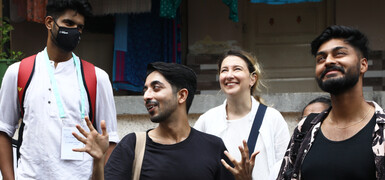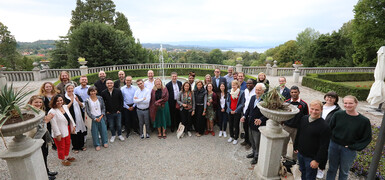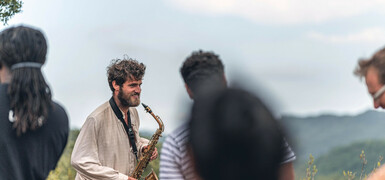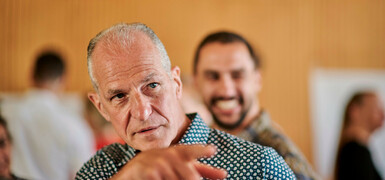
Impact Alliances: The next Evolution for Philanthropy
How can Impact Alliances be a powerful tool in solving complex social challenges? Interview with Tim Draimin
In November 2021, the Connecting Networks community welcomed Tim Draimin as the keynote speaker at its Learning Lab in Vienna, Austria, on the topic of Impact Alliances. With years of experience in developing and managing Impact Alliances, Tim worked with participants as they explored the potential of deep collaboration to address complex challenges and to drive social innovation.
Following up on the Learning Lab, Tim joined us for an interview to discuss the changing role of philanthropy, his experiences working with Impact Alliances, and the urgent need for deep collaborative efforts.
Challenges such as climate change or polarized societies are both urgent and overwhelming. How is the field of philanthropy currently positioned to take on such topics?
Tim: We are in an age of transition unlike anything we have ever seen, where we’re facing both the existential threat of climate change as well as critical social challenges. Philanthropy has a huge role to play, but foundations have been so focused on their own goals as autonomous actors that they’re only now beginning to realize that they need to operate in a much larger field to bring about change.
Simply put, foundations cannot accomplish change at a systems-level while working individually. They need committed and diverse partners with whom they can create and unlock new impactful value that would otherwise remain elusive to the single foundation actor.
Today, they have a real opportunity to be catalysts for building problem-solving platforms that are capable of working at scale.
How far do you think philanthropy is from realizing that potential?
Tim: We still have got a long way to go. Deep collaboration – where foundations are capable of putting the interests of the collectivity at the forefront and are comfortable leaving their ego and their brand at the back – is a very hard thing to achieve.
For the last half-century, foundations have focused on their role as individual grant-makers. Disrupting that pattern of behavior requires a new mindset around how foundations understand their role in social change.
We need to build deep collaborative relationships with other organizations that focus on more than just shared program activities. The real challenge to unlocking new value is finding the capability to create continuous innovation together.
Many foundations are already engaged in collective impact. What is the difference between that and an Impact Alliance?
Tim: Collective impact is an early iteration of an Impact Alliance. It’s where somebody already has a plan that they want to implement, and they reach out to the partners they need, divvy up the work and implement it – but all of the strategy is done a priori.
An Impact Alliance is where you have a North Star goal of what you’re trying to achieve and an initial hypothesis about how to do it. There’s also a shared understanding that an Impact Alliance is going to be an iterative process of testing and fine-tuning ideas that are evolving.
All parties involved need to be ready to commit to a long timeframe and the quality of the relationship needs to be very high to sustain this ongoing innovation capability. People refer to that as “emergent learning.”
Do you have an example of an organization that was able to do that?
Tim: I was the CEO of a national foundation focused on social-environmental change. Our signature project was an initiative that supported work with local populations and indigenous people. The goal was to create an ecosystem management plan to protect the old growth forest in Canada’s Great Bear Rainforest. This initiative started as a result of individual environmental groups realizing that they could create more value if they worked in concert. Starting as a group of environmentalists, it ended up evolving into the creation of different platforms of collaboration between them and First Nation people, businesses, and government. Together, they created a large-scale forest management plan, and generated resources and new types of institutional support systems. Previously, success was only measured by the hectares protected. In this case, the alliance pivoted to an understanding that they needed to create a new model of conservation, where the social needs of the local populations are integrated into the conservation plan. What emerged was “integrated conservation.” This model of large-scale integrated conservation was later adopted by others, including the Canadian Boreal Trust.
These types of alliances take a lot of time to reach their full potential, but a lot of people feel a great sense of urgency. How can we strike a balance?
Tim: We can have a multi-track approach to how we’re investing our time and resources. We can initiate collective endeavors with shorter-term activities to start testing ideas and connecting to the broader systems and networks that we seek to support and influence. However, we also need to protect our resources for the more long-term strategic goals. This does not need to be a conflict though, as the urgent things will end up generating knowledge that we can use while evaluating ways to develop our medium- and long-term strategies.
What can individuals do to nudge an organization towards more collaboration?
Tim: We need to share inspiring stories about successful Impact Alliances and how the scale of their impact eclipses what individual organizations are capable of doing alone. Even extremely large organizations are starting to move towards collaboration to get things done, exemplified by the CARE Fund or Tipping Point. This signals a shift, recognizing that lasting social change needs an ecosystem of actors working in tandem.
What’s ahead for the field of philanthropy?
Tim: I predict that we are going to see an ongoing evolution in the type and sophistication of innovative, collaborative alliances and platforms that will emerge in the coming years. Foundations will be central to that, because they have the ability to bring together money, relationships, long-term perspectives, strategic thinking, and strategic foresight.
Foundations are in an enviable position to provide leadership to this emerging field of Impact Alliances.
How can Connecting Networks and the iac Berlin support this?
Tim: The iac Berlin is working in one of the most important areas today. They are helping to garner recognition for the need for collaboration and Impact Alliances as well as undertaking capacity building, and creating the space for potential Impact Alliances to emerge. That is absolutely essential. If we want to achieve the impact that we’re seeking, we have to help everyone recognize the value of deep collaborative work. And we need to recognize how urgent this work is now.
About Tim Draimin
Tim Draimin is a Senior Fellow at Community Foundations of Canada and a long-time leader in Canada’s social innovation sector. He was the Executive Director of the Social Innovation Generation and founding CEO of Tides Canada Foundation, where he established Canada’s first national support system for social entrepreneurs and supported BC’s Great Bear Rainforest initiative, a world-renowned model of integrated conservation. Tim has worked and consulted internationally and serves on the board of various organizations active in social innovation.
The Connecting Networks Learning Labs
The Connecting Networks community offers a range of activities and learning formats for peer exchange and shared learning on topics ranging from network building and collaboration to strategy development and social innovation. Designed by the iac Berlin, Learning Labs are 2-3 day workshops that explore and advance dialogue around key themes and emerging issues.
Do you want to discuss Impact Alliances, Connecting Networks and our learnings in more depth? Please get in touch with:
Darius Polok
Managing Director
darius.pook@iac-berlin.org








